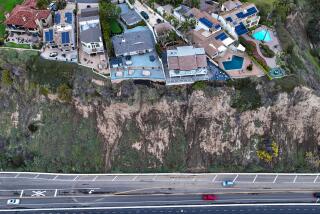Tanning’s Dark Side Isn’t a Peeling : Doctors discuss and show photos of Orange County patients who got much more than burned from sun exposure.
- Share via
TUSTIN — If you think you look good with a suntan--and who doesn’t?--try picturing yourself with the potential side effects of that tan.
How attractive would you be without a nose, or with a bizarre fleshy growth hanging from your cheek? What if that same pigment that makes you look so young and healthy concentrated itself in one spot to make your left ear look like a charcoal briquette?
Doctors from Pacific Coast Comprehensive Cancer Center at Healthcare Medical Center of Tustin turned a roomful of stomachs last Tuesday night with photo after shocking photo of Orange County patients who got much more than burned by exposing themselves to the sun. And the images, even after doctors had done their best to repair and reconstruct damaged skin, were enough to turn even the most ardent tanner pale.
Year after year of warning people about the dangers of tanning has left many doctors feeling “like we’ve been banging our heads into a wall,” says Dr. Glen Justice, the center’s director.
Tanning is officially “out,” has been for several years now, but still the sun-worshipers bake themselves on the beach, in the back yard or by the pool. With the almost constant sunshine and mild climate here, they can do so all year long. And if that’s not enough, on cloudy days they can drop by the tanning salons that seem to be in every corner shopping center for a quick color boost.
There is absolutely no such thing as a safe tan, say Justice and other doctors who see the gory and sometimes deadly results of sun exposure. Each and every exposure to the sun, however brief, contributes to skin damage.
“My 10-year-old looks at smoking cigarettes as comparable to using cocaine,” Justice says. “That’s obviously not quite appropriate, but hopefully, someday we’ll have that kind of awareness about the dangers of suntanning.
“It’s really frustrating. Even nurses who know better go out in the sun, or into tanning booths. It’s still looked on as desirable. I look forward to the day when people look at someone with a suntan and say, ‘Sure, he looks good, but what a jerk.’ ”
Justice dreams of a massive education campaign similar to the anti-smoking effort that began in the ‘60s or the anti-drug program that started in the ‘80s.
Before people can get the facts about the dark side of suntanning, they need to abandon some of the myths. Tanning gradually, once recommended as the best way to deal with the summer sun, is now recognized as being dangerous as well. Tanning in the off-season, or during the non-peak sun hours, also is hazardous. Covering up, smearing on sunscreen or staying in the shade are simply the only defenses, the doctors say.
Both forms of ultraviolet radiation from the sun--UVA and UVB--cause damage. UVB rays are the primary cause of sunburn, skin cancer and premature skin aging, but UVA rays penetrate the outer layer of skin and can cause abnormalities in collagen and elastin. Unlike UVB rays, UVA are constant.
Skin cancers are the most prevalent form of the disease in the United States now, with more than 1 million cases diagnosed each year. Malignant melanoma, the most deadly form of skin cancer, is increasing dramatically, with the number of cases tripling every decade, Justice says.
Forty years ago, skin cancer was virtually unheard of in patients as young as 40, but now it is common in patients in their 30s and showing up more frequently in those as young as 20.
Although melanoma is the most likely of the skin cancers to spread to other parts of the body, squamous cell carcinoma also can do so. While basal cell carcinoma rarely spreads, it can form large growths that can eat into healthy tissue if left untreated.
“We predict that with this whole tanning booth thing, it’s going to be an increasing problem over the next several decades,” says Justice, who himself sees 500 to 600 skin cancer patients each year.
“I just had three new melanoma patients today,” says Dr. June Beamer-Patton, a dermatologist in Tustin.
“The body remembers every sunburn, every tan, every 10-minute walk in the sun,” Beamer-Patton says. “Tanning is an injury response.”
Even driving or riding in a car can cause damage, she says. “Statistically you’re most likely to develop lesions on the side you usually ride in in the car.”
Dr. Donald Altman, a plastic and reconstructive surgeon, showed before and after pictures of some of the patients he treated.
“I’m doing the best I can to make these people look as good as they can,” he said.
Dr. Chah Chahbazian, a radiation oncologist, showed slides of patients who were treated with radiation. Although radiation produces good results in many cases, he said that some patients who had been treated with radiation for some other problems, such as acne, later developed skin cancer as a result.
Early treatment is essential in improving the prognosis for skin cancer, and that depends on early detection. During the month of May, dermatologists nationwide are donating their time to provide free skin cancer screenings.
In Orange County, the local office of the American Cancer Society ((714) 751-0441) will provide referrals and information on participating doctors and the times they are available.


